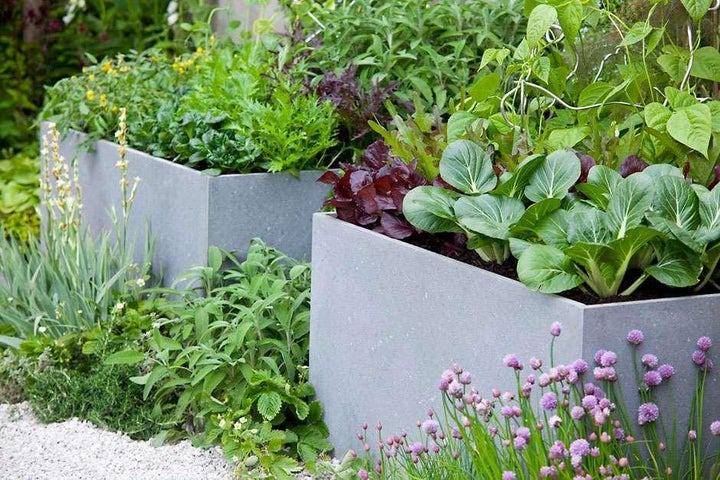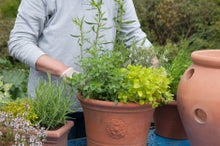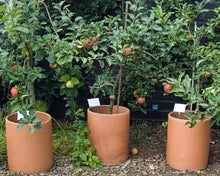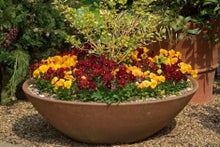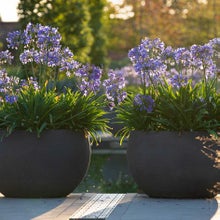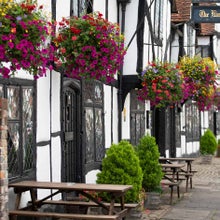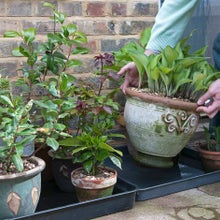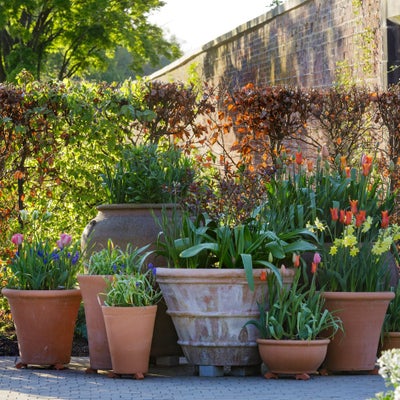
Quick facts
You can grow almost any type of plant in a container, from bedding plants to veg, and even small trees
It is essential to have drainage holes in the base of a container
Containers need to be watered regularly in spring and summer
Why grow in containers
Containers come into their own when soil space is limited, such as in small gardens and on patios, doorsteps and balconies. In some outdoor spaces, a container garden may be the only option for growing plants. You can move them around more easily than plants growing in the ground, and their limited size means they’re great for beginners growing small quantities of veg or herbs, for example.
Almost any type of plant can be grown in a container, from colourful seasonal bedding to more permanent shrubs, climbers, herbaceous and even small trees . Clipped topiary in a pot makes a great focal point and adds a formal flourish to a front doorstep. Many fruits and vegetables can be successful in pots too, as can some roses . Drought-tolerant plants, such as Mediterranean herbs , are ideal for planting in pots, especially in our warming climate.
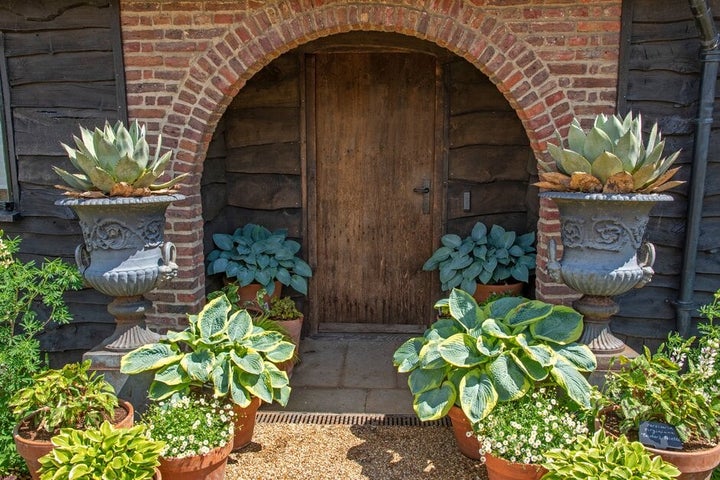
Just bear in mind that plants in containers need more watering and feeding than those growing in the ground, as they have only a small amount of to sustain them. They are also more susceptible to cold, as the roots are more exposed than those buried deep in the earth, so may need additional protection in winter. Container plants are also prone to waterlogging in winter, so make sure the drainage is good, especially during the wetter seasons.
For more on sustainable container gardening and maintenance, see our guides:
Choosing containers
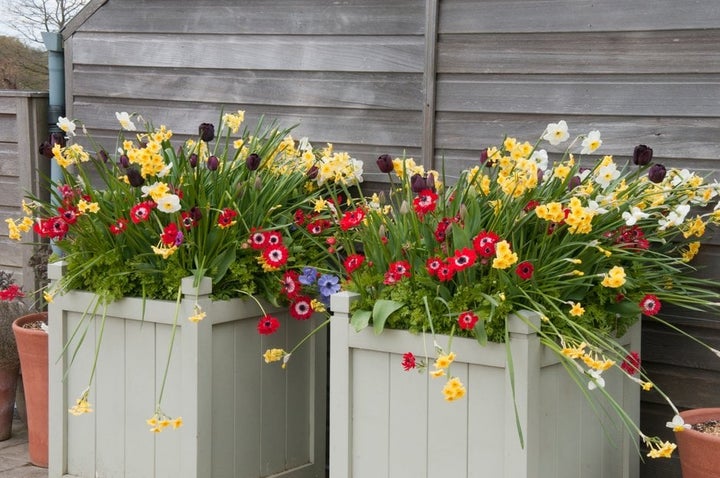
Containers are available in a wide range of materials – with pros and cons to each. The main options are:
- Terracotta/clay – these look attractive, but unglazed pots are porous so dry out more quickly than other materials. Terracotta is also prone to cracking in winter, so choose frost-proof pots, rather than just frost-resistant. High-quality pots can be expensive, but if well looked after they can last for many years
- Plastic –these are lighter than terracotta and don’t dry out as easily. They’re available in a wide range of shapes, colours and finishes, with some resembling terracotta, lead or stone, but at far less cost. Plastic can degrade over time due to sun damage and may not be recyclable. If buying new plastic containers, look for those made from recycled material – see our guide to plastic-free gardening
- Metal – this is a very popular material, usually giving a modern look, although lead planters are a traditional favourite. They are frost-proof and durable, but expensive and some may suffer corrosion in the long term. The main disadvantages are that they heat up quickly in summer and get very cold in winter
- Wood – half-barrels are popular containers for fruit trees, wooden troughs can look very attractive, crates and wine boxes are inexpensive and sustainable . Wood rots over time, but you can extend the lifespan of a wooden container by lining it with an old bag and punching holes in the base or by painting with wood preserver
- Recycled materials – almost any large container can be repurposed as a plant pot, including tin baths, Belfast sinks, farmyard troughs, metal dustbins and much more – just use your imagination. Empty compost bags are also ideal for growing potatoes. Just remember to make drainage holes in the base

Size and shape are also important when choosing containers:
- Large containers, with a greater volume of compost, dry out more slowly than small containers, so are less work to look after. It’s usually easier, and often looks better, to have fewer large containers, rather than lots of small ones
- Shallow containers dry out quickly, making them better suited for small drought-tolerant plants and alpines
- Tall, narrow containers are prone to being blown over, particularly if they contain tall plants. Add a layer of bricks or stones in the base to help stabilise them, and position in a sheltered spot
- Urn-shaped pots are best avoided for long-term plantings. It can be hard to remove the from a pot that is wider in the centre than at the top, causing problems when repotting
- Use the rootball as a guide when choosing a pot for a single specimen plant, particularly slow growers like camellias . The ideal pot size is only slightly larger than the rootball. Avoid using an overly large pot , as the excess compost can easily become , causing the roots to rot
Choosing compost

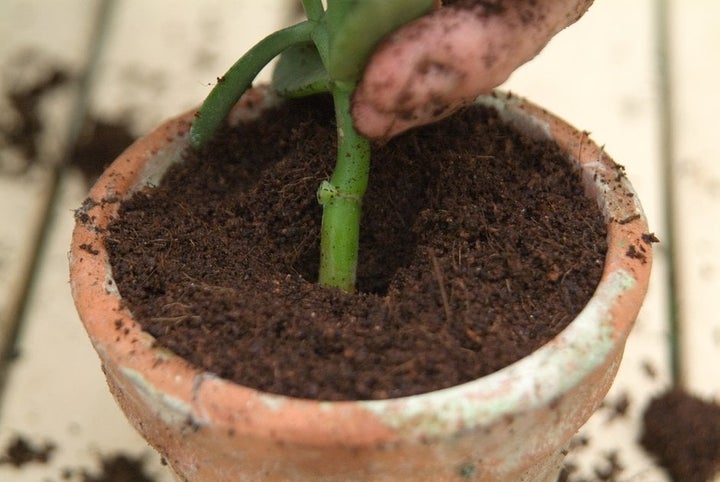
Potting composts aren’t the same as garden compost you make in your bin. Commercial potting composts contain a mix of ingredients, often including coir, grit and loam. Always choose peat-free compost .
The best compost for containers will depend on the types of plants you are growing. The three most popular types of compost for container planting are:
- multi-purpose peat-free composts – these are generally for short-term plants, such as bedding displays and veg crops
- soil-based peat-free composts, such as peat-free John Innes No. 3, are for longer-term plants. You can make your own from a mixture of two parts garden soil to one part garden compost
- ericaceous composts – there are a range of high-quality peat-free options available for acid-loving plants such as blueberries and rhododendrons
You can also add slow-release fertiliser to potting compost to provide a steady supply of to permanent plantings or summer bedding displays.
For larger containers, reduce the amount of bagged compost you need to buy by mixing in some homemade compost if you have it.
Planting into containers
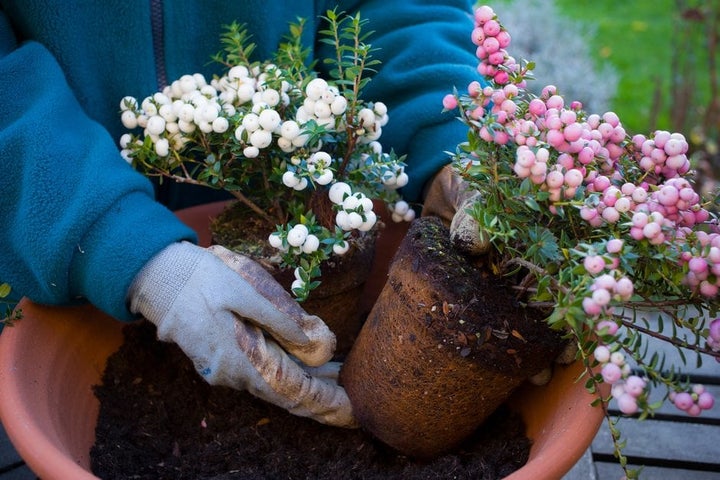
The best time to plant up containers depends on the type of plants:
- Permanent plants – preferably in early spring, as they will establish more rapidly, but early autumn is also fine
- Tender summer-flowering plants – in late May/early June, after all risk of frost has passed
- Winter displays – in autumn
- Spring bulbs – in autumn
- Summer (such as lilies ) - in autumn or spring
Planting containers is easy – see our handy guides on how to plant pots and hanging baskets:
Aftercare
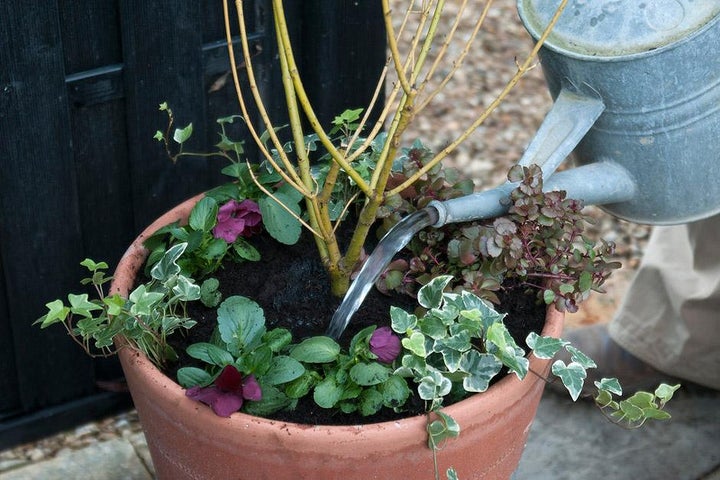
Plants in containers usually need more regular maintenance than those in open ground. With the limited amount of and restricted root space, container plants are less self-sufficient and need regular watering and occasional feeding.
For more on looking after containers, see our guide:
Problem solving
Growing in containers is generally easy, but the plants do need regular maintenance, and certain pests and diseases may be more common, so keep a careful check on your plants.
- , especially in winter, can cause roots to rot and plants to die. Make sure the drainage holes are kept clear by raising pots onto bricks or pot feet if possible. Remove any trays or saucers before winter, so pots aren’t left standing in water
- Lack of water can be a major issue in summer, especially in smaller containers and in full sun. You may need to water up to twice a day in hot weather. Place a tray or saucer under containers in summer to catch any excess water and choose drought-tolerant plants to help reduce the need for watering. Also see our guide to watering containers
- Planting into an overly large container – or overpotting – can lead to root rot, if plants end up sitting in too much damp compost. Choose a pot that’s only slightly larger than the , or fill a large container with several plants
- Vine weevils can be a problem for any plants in containers, but fuchsias , heucheras , strawberries , primulas and sedums are particularly vulnerable. Ants are also prone to colonising containers
- Stressed plants in containers may be prone to diseases such as powdery mildew s and rusts
- Algae, liverworts and moss can be unwanted guests in containers
